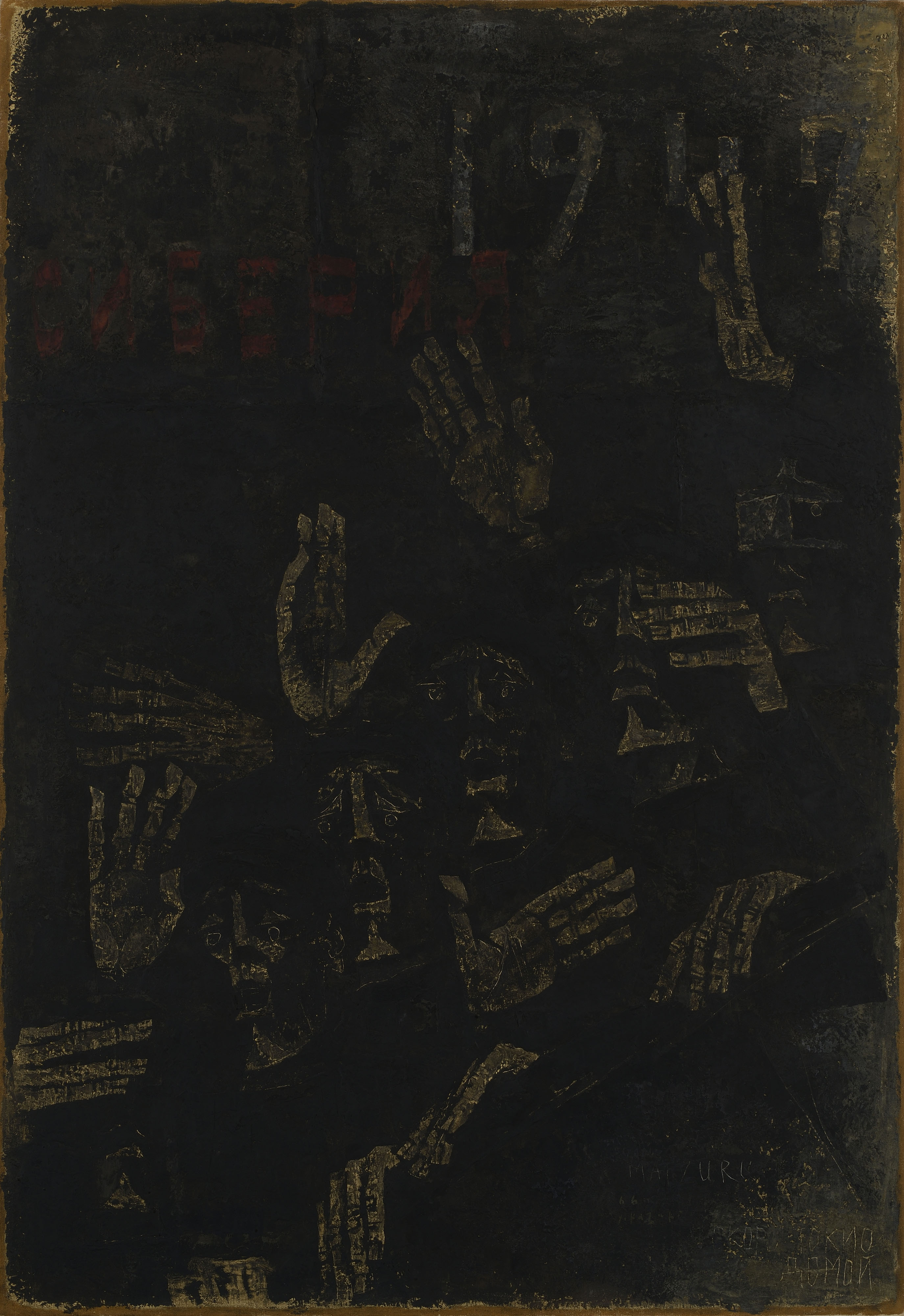
ふくいん(たらっぷ) 復員〈タラップ〉
1967(昭和42年)
油彩/カンヴァス
〈作品解説〉
画面右上から左下に向けて、タラップを降りる人物が、絵のこちら側に集まる人々に手を振っています。彼らは太平洋戦争終結後、シベリアに連行されて強制労働を課された旧日本軍の兵隊たち。過酷な抑留生活を耐え忍び、ついに故国に帰り着いた瞬間が描かれています。
画面右上には、復員の年「1947」が記され、その左には赤いロシア文字で「シベリア」と刻まれています。右下には「舞鶴」、その下にロシア文字で記されているのは、収容所でソ連兵に何度も聞かされた「スコーラ・トキオ・ダモイ」、すなわち「帰国は近いぞ」のフレーズ。
最上段の眼帯をつけた人物は、画家の自画像です。帰りのシベリア鉄道で汽車の煤煙が目に入って、帰国の時、香月は目を傷めていました。タラップを降りる人々のやせこけた顔には、待ちに待った帰国を果たした満面の笑みはありません。生きて帰ることが出来た人々の姿には、シベリアで命を落とした人々の影が重ねられているのです。
〈画家のことば〉
5月21日、船は故国へ近づいた。朝早くから甲板へ出て日本の山が見えるのを待った。シベリヤ鉄道の汽車の煤煙が目に入って、片目は眼帯でかくされていたが、シベリヤの索漠たる風景を見馴れた目に、故国の新緑は痛いほどあざやかだった。ゆれるタラップを踏みしめ、港に集まる人々を見た時、ふと自分が亡霊のように思えた。自分の前の男も、後の男も亡霊のような気がした。なぜだろうか。自分が亡霊というより、背中に亡霊を背負っている感じだったかもしれない。セーヤで死んだ30人あまりの仲間の亡霊が、いっしょにこの船に乗って、帰って来たのかも知れない。
『シベリヤ画集』(新潮社、1971年)
香月泰男【かづき やすお】
生没年 1911~1974(明治44年~昭和49年)
山口県大津郡三隅村(現・長門市三隅)に生まれた香月泰男は、東京美術学校で油彩画を学び、美術教員の傍ら国画会を中心に作品を発表しました。1967年、太平洋戦争への従軍と戦後のシベリア抑留の経験を描いた「シベリア・シリーズ」により、第一回日本芸術大賞を受賞。その作品は今日も多くの人々を惹きつけています。
| 寸法 | 162.1×111.6cm |
|---|---|
| 形状 | 額装 |

Demobilization "Gangway"
1967
Oil on canvas
〈Commentaries on works on display 〉
People descend the gangplank from the top right to the bottom left of the picture, waving at the supposed crowd gathered outside the painting. They are former Japanese soldiers who were captured at the end of the Pacific War (WWII) and shipped off to labor camps in Siberia. Somehow they have managed to survive their grueling treatment, and this picture captures the moment they finally arrive back in the homeland.
At the top right we see the year of repatriation, 1947, and to the left of that the Russian word for Siberia, in red. At the bottom right is the word Maizuru (the name of the port they arrived at) , and below that is a Russian phrase that they heard over and over again in the camp: Скоро Токио домой, which means “you’re going home soon.”
The figure at the top with an eyepatch is the artist himself. Kazuki got cinders in his eye while riding the steam train out of Siberia, and his eye had not yet healed by the time of his return to Japan. The soldiers are emaciated after their experiences, showing little sign of joy at the long-awaited homecoming. For those who lived long enough to make it back from Siberia, memories of those who were lost cast a heavy shadow.
〈Painter’s words〉
On May 21, as our ship approached the coastline of Japan, I awoke early and paced the deck, hoping to catch a glimpse of the familiar mountains of the homeland. A cinder from the steam train that carried us out of Siberia had lodged in one eye, which was now covered with an eye patch. My eyes had become so attuned to the desolate Siberian landscape that the verdant green of Japan in spring almost made them hurt. As I descended the wobbly gangway and looked out over the crowd gathered at the port, I almost felt like the spirit of a departed soul rather than a living being. The man in front of me too, and the man behind me… for reasons that I can’t articulate, I felt that we were all spirits. Or maybe it wasn’t so much that I was a spirit—maybe it was that I was carrying all the spirits of the departed on my shoulders. More than 30 of my friends had died at Seya. Their spirits were surely on the boat with us, and had come home with us.
Siberian Series (Shinchosha, 1971)
Kazuki Yasuo 1911 – 1974
Born in Misumi-mura (now Misumi, Nagato City) in Otsu-gun, Yamaguchi Prefecture. Studied oil painting at Tokyo School of Fine Arts, then taught fine art while producing works that were primarily exhibited at Kokugakai (National Painting Association). Kazuki was sent to fight in the Pacific War (WWII), then interned in Siberia after the war. This experience resulted in the Siberia Series, which won the inaugural Japan Art Grand Prize in 1967. This series is considered an important body of work that still resonates widely today.
| Size | 162.1×111.6cm |
|---|

複員(舷梯)
1967
《作品解說》
畫麵的右上方到左下方,走下舷梯的人正在向畫麵這一側的人們揮手。他們是太平洋戰爭結束後,被強製帶到西伯利亞勞動的前日軍士兵。經曆了殘酷的拘留所生活後,終於回到祖國的瞬間。
畫麵右上方寫著複員年“1947”,其左側用紅色的俄羅斯文字刻著“西伯利亞”。右下方寫著“舞鶴”,下麵用俄羅斯文字寫著,在戰俘營裏聽蘇聯士兵說過很多次的“Скоро Токио домой(sukora-・tokio・damoi)”,也就是“快回國了”的短語。
最上段戴著眼罩的人物,是畫家的自畫像。在歸途的西伯利亞鐵路上,火車的煤煙飛入眼中,歸國時,香月的眼睛因此受傷。在走下舷梯的人們消瘦的臉上,看不到期待已久的歸國的笑容。在活著歸來的人們身上,疊加著在西伯利亞失去生命的人們的影子。
《畫家的話》
5月21日,船接近了祖國。一大早就來到甲板上,等著看到日本的山。西伯利亞鐵路的火車煤煙混入眼中,一隻眼睛被眼罩遮住,但對於看慣了西伯利亞冷漠風景的眼睛來說,故國的新綠顯得尤為刺眼。踏著搖晃的舷梯,看著聚集在港口的人們,突然覺得自己就像亡靈一樣。自己前面的男人,後面的男人也像是亡靈一樣。這是為什麽呢?與其說自己是亡靈,不如說是背上背著亡靈的感覺。也許,在塞亞遇難的30多名同伴的亡靈也乘坐這艘船一起歸來了。
《西伯利亞畫集》(新潮社 1971年)
香月泰男
生卒年 1911~1974(明治44年~昭和49年)
香月泰男出生於山口縣大津郡三隅村(現長門市三隅),在東京美術學校學習油畫,在擔任美術教員的同時,主要在國畫會發表作品。1967年, “西伯利亞係列 “獲得了第一屆日本藝術大獎,描繪了香月在太平洋戰爭中服役以及戰後被關押在西伯利亞的經曆。那些作品至今也受很多人歡迎。
| 尺寸 | 162.1×111.6cm |
|---|

복원(트랩)
1967
화면 오른쪽 상단에서 왼쪽 하단을 향해 트랩에서 내리는 인물들이 화폭 너머로 모여든 사람들에게 손을 흔들고 있습니다. 그들은 태평양 전쟁 종전 후 시베리아에 연행되어 강제 노동을 해야했던 구 일본군 병사들입니다. 가혹한 억류생활을 이겨내고 마침내 고국으로 돌아온 순간을 그렸습니다.
화면 오른쪽 상단에는 복원 군인들이 귀향을 하게 된 해인 「1947」이 적혀있고, 그 왼쪽에는 빨간색으로 「시베리아」가 러시아어로 새겨져 있습니다. 오른쪽 아래에는「舞鶴(마이즈루)」 , 그 아래에 러시아 글자로 써있는 것은 수용소에서 몇 번이고 들은 소련 군인들이 한 말 「스콜로 토쿄 다모이(Скоро Токио домой)」 즉,「귀국이 머지 않았다(곧 도쿄의 집)」는 뜻의 문장입니다.
제일 위에 안대를 한 인물은 화가 자신의 자화상입니다. 일본으로 돌아오는 시베리아 철도에서 기차의 매연이 눈에 들어가 귀국 당시 가즈키는 눈에 부상을 입었었습니다. 트랩에서 내리는 사람들의 마르고 검게 탄 얼굴에서 손꼽아 기다리던 귀국을 이뤄냈다는 기쁨의 미소는 볼 수 없습니다. 살아 돌아올 수 있었던 병사들의 얼굴에는 시베리아에서 생을 마감한 동료들의 그림자가 드리워져 있는 것입니다.
가즈키 야스오
생몰년 1911~1974 (메이지44년~쇼와49년)
야마구치현 오오츠군 미스미(현 나가토시 미스미)에서 태어난 가즈키 야스오는, 도쿄 미술학교에서 유화를 공부하고, 미술 선생님으로 재직하는 한편, 당시 일본 유력 미술 단체 중 하나인 국화회를 중심으로 작품을 발표했습니다. 1967년, 태평양 전쟁에서의 종군 생활과 전쟁 후의 시베리아 억류 경험을 그린 「시베리아 시리즈」를 통해 제1회 일본 예술 대상을 수상. 그 작품은 현재까지도 많은 사람들을 매혹시키고 있습니다.
| 치수 | 162.1×111.6cm |
|---|
